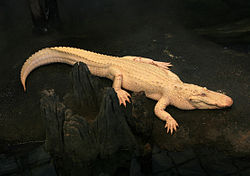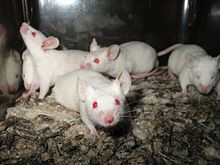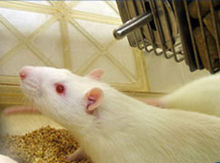
Back Gapi ACE مهق Arabic Albinismu AST Albinizm AZ آلبینیزم AZB Ugis BCL Альбінізм BE Альбінізм BE-X-OLD অ্যালবিনিজম Bengali/Bangla Albinizam BS
Albinism is the congenital absence of melanin in an animal or plant resulting in white hair, feathers, scales and skin and reddish pink or blue eyes.[1][2] Individuals with the condition are referred to as albinos.
Varied use and interpretation of the terms mean that written reports of albinistic animals can be difficult to verify. Albinism can reduce the survivability of an animal; for example, it has been suggested that albino alligators have an average survival span of only 24 hours due to the lack of protection from UV radiation and their lack of camouflage to avoid predators.[3] It is a common misconception that all albino animals have characteristic pink or red eyes (resulting from the lack of pigment in the iris allowing the blood vessels of the retina to be visible); this is not the case for some forms of albinism.[4] Familiar albino animals include in-bred strains of laboratory animals (rats, mice and rabbits), but populations of naturally occurring albino animals exist in the wild, e.g., Mexican cave tetra. Albinism is a well-recognized phenomenon in molluscs, both in the shell and in the soft parts. By definition albinism is a genetic condition, however a similar coloration could be caused by diet, living conditions, age, disease, or injury.[5]
Oculocutaneous albinism (OCA) is a clearly defined set of seven types of genetic mutations which reduce or completely prevent the synthesis of eumelanin or pheomelanin, resulting in reduced pigmentation.[6] Type I oculocutaneous albinism (OCA1a) is the form most commonly recognised as 'albino' as this results in a complete absence of melanin in the skin, hair/fur/feathers, and pink pupils, however this has led many to assume that all albinos are pure white with pink pupils, which is not the case.[7][8][6]
In plants, albinism is characterised by partial or complete loss of chlorophyll pigments and incomplete differentiation of chloroplast membranes. Albinism in plants interferes with photosynthesis, which can reduce survivability.[9] Some plant variations may have white flowers or other parts. However, these plants are not totally devoid of chlorophyll. Terms associated with this phenomenon are "hypochromia" and "albiflora".[10]
- ^ Oetting, William S; Adams, David (2018). "Albinism: Genetics". eLS: 1–8. doi:10.1002/9780470015902.a0006081.pub3. ISBN 9780470016176. S2CID 239781411 – via John Wiley & Sons, Ltd.
- ^ "Albinism". The Free Dictionary. Retrieved January 31, 2015.
- ^ "New Albino Alligators". GeorgiaAquarium.org. The Georgia Aquarium. Archived from the original on January 20, 2015. Retrieved January 20, 2015.
- ^ "Information Bulletin – What is Albinism?". National Organization for Albinism and Hypopigmentation. January 27, 2018. Retrieved June 23, 2020.
- ^ McCardle, Hayley (May 2012). Albinism in wild vertebrates (MSc thesis). Texas State University. Retrieved January 24, 2015.
- ^ a b "Oculocutaneous Albinism". NORD (National Organization for Rare Disorders). Retrieved June 23, 2020.
- ^ Gunnarsson, Ulrika; Hellström, Anders R.; Tixier-Boichard, Michele; Minvielle, Francis; Bed'hom, Bertrand; Ito, Shin'ichi; Jensen, Per; Rattink, Annemieke; Vereijken, Addie; Andersson, Leif (February 2007). "Mutations in SLC45A2 Cause Plumage Color Variation in Chicken and Japanese Quail". Genetics. 175 (2): 867–877. doi:10.1534/genetics.106.063107. ISSN 0016-6731. PMC 1800597. PMID 17151254.
- ^ Brilliant, Murray H. (2001). "The Mouse p (pink-eyed dilution) and Human P Genes, Oculocutaneous Albinism Type 2 (OCA2), and Melanosomal pH". Pigment Cell Research. 14 (2): 86–93. doi:10.1034/j.1600-0749.2001.140203.x. ISSN 1600-0749. PMID 11310796.
- ^ Kumari, M.; Clarke, H. J.; Small, I.; Siddique, K. H. M. (2009). "Albinism in plants: A major bottleneck in wide hybridization, androgenesis and doubled haploid culture". Critical Reviews in Plant Sciences. 28 (6): 393–409. Bibcode:2009CRvPS..28..393K. doi:10.1080/07352680903133252. S2CID 85298264.
- ^ "Albiflora". Archived from the original on February 2, 2015. Retrieved January 28, 2015.



